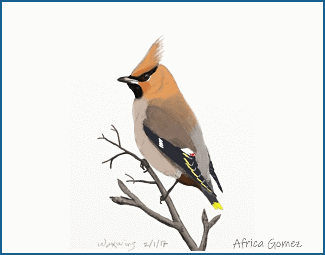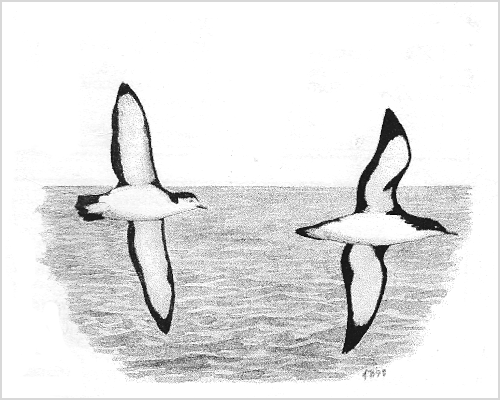Dee Estuary Birding
Monthly Newsletter...
December 2023 Newsletter

Barolo Shearwater

(Sketch published on the cover of CAWOS Bird News October 1998)

I received October's edition of British Birds on the
16th and saw it was the one with the Report on Rare Birds 2022. So I
quickly scanned through the article looking for any local records which
had been accepted. First there was the Hoylake Pallid Swift, then the
Wilson's Phalarope at Burton Mere Wetlands (seen in 2021 but submitted
late) then - well, I got a shock as I saw my name. It was the Little
Shearwater from 2010 - now called Barolo Shearwater.
I remember very well the day I saw it. It was the
first day of strong north-west winds which lasted five days producing
one of the best Leach's Petrel passages ever seen here with several
hundred each day from the 15th to 17th September. I went down to
Hoylake Lifeboat Station on the 14th on the falling tide hoping to see
a few of the Petrels. I was thrilled to see ten, but I remember being
surprised at also seeing a Shearwater. As 99.99% of Shearwaters coming
past here are Manxies it didn't occur to me it might not be one of
those, but what susprised me was that (a) it was late for a Manxie to
still be here, (b) it was flying over the surf on the tide edge - every
other Manxie I'd seen was always well out over the sea, (c) it's flight
was quite fluttery, not fast and strong like a Manxie and (d) it's
wings were noticably white underneath and they seemed to be relatively
stubbier and wider than a 'normal' Manxie. Did I immeadiately realise
that I'd just seen my first Little Shearwater and start jumping for
joy? Well, no, I'm ashamed to say my total inexperience with
Shearwaters meant I just assumed it was just an odd looking Manxie.
However, others, who did know their Shearwaters,
were jumping for joy just a short distance down the coast, as I was
soon to find out. I met Chris Williams as I was walking back to the car
and, after a brief chat about the Leach's Petrels, he says "Allan
Conlin had a Little Shearwater off Dove Point". A quick phone
call to Allan confirmed that the bird flew west from Meols (i.e.
towards where I was) and he had seen it (with Al Orton) just a few
minutes before I saw my 'odd looking Manxie'. So I take no credit
whatsoever for identifying it, but at least I was aware that I had seen
something different and the Cheshire Bird Recorder urged me to submit
to BBRC what I had seen, and 13 years later it has been accepted! The
first ever Barolo Shearwater (as Little Shearwaters are now called) to
be accepted for the Dee Estuary/North Wirral coast. A great record,
thanks to Allan and Al.
But why did it take 13 years? I quite from British Birds:
This Report finally sees
the results of BBRC's review of 'Little Shearwaters'. The review
stalled for several years but, with today's greater knowledge of the
species' identification criteria and welcome input from acknowledged
seabird experts, the Committee has now completed its work.
In total 14 Barolo Shearwaters were accepted in that British Birds report - some going back all the way to 2000.
To give you an idea how lucky we were to see our bird I quote Magnus Robb who writes in the excellent 'The Sound Approach' website:
Barolo Shearwater Puffinus baroli is
easily the most elusive shearwater in the North Atlantic. Not that this
species is incredibly rare, although with just 3000 to 4400 pairs
(Brooke 2004), it could hardly be described as common. Its population
is twice that of Balearic Shearwater P mauretanicus,
and yet Barolo is far more difficult to see. A typical view is from the
rear, a tiny shearwater flying away from your boat as fast as its
little wings will carry it.
Although the 2010 bird was the first to be accepted
for the Dee Estuary and North Wirral it was not the first to be seen
there as one recorded from Seaforth on the River Mersey on September
5th 1992, and accepted by BBRC, was also seen from New Brighton but not
submitted as views were poor and they couldn't rule out Manx
Shearwater.
There have been several other possible/probable records plus two from inland Cheshire, and I finish by quoting from my Peleagic Seabirds in Liverpool Bay article (September 2021 Newsletter), you may be amused by the last paragraph!:
Barolo Shearwater (Puffinus baroli)
Most birders refer to these as Little Shearwaters,
which is what they used to be officially called. These have now been
split into three very similar species - Audubon's, Barolo and Boyd's
which in the field are near impossible to tell apart. But where it has
been possible to identify the species in the UK they have all proved to
be Barolo and these breed in the Azores, Canaries and Madeira.
There have been several records of 'Little Shearwaters' off the Dee Estuary and north Wirral, but for one reason or another none have, so far, been accepted by BBRC. Strangely, there are two inland records for Cheshire which have been accepted - one was found moribund on May 10th 1958 at Stockport and a sick individual was present at Rostherne Mere from Jun 29th to Jul 3rd 1977 when it was picked up and later died.
Here are the other records:
1971 One off Meols on 20th October. Not proven.
1976 One off Hilbre on 1st September. Not proven.
1984 One off Hilbre on 2nd September. Accepted but later
withdrawn.
1985 One off Hilbre on 21st September. Not proven.
1992 One in River Mersey mouth on 5th September. Recorded from
Seaforth (Lancs) and accepted. Apparently seen from New Brighton but no
record from there was submitted.
2000 One off Hilbre on 6th September. Not proven.
2010 One off Meols and Hoylake on 14th September. Record
submitted but pending whilst under review.
So all a bit frustrating but this comment in the 1993 Report of Rare Birds in Great Britain caught my eye "This species continues to cause the BBRC severe headaches, since most descriptions just fail to provide that convincing element of proof. The Committee acknowledges, however, that this is a difficult species to prove on paper and one which, by its nature, seldom gives observers a second chance." Looking at BBRC's 'work in progress' spreadsheet no less than 67 records of Barolo/Boyd's/Audubon's Shearwater are currently under review, going as far back as 1967! But from 2018 BBRC now seem to be either accepting or rejecting records and there was one accepted in 2018 and two in 2019 - all as the species group of Barolo/Boyd's/Audubon's. It would certainly be nice if the 2010 bird seen off Meols and Hoylake was accepted as I was one of the birders who saw it.
Richard Smith